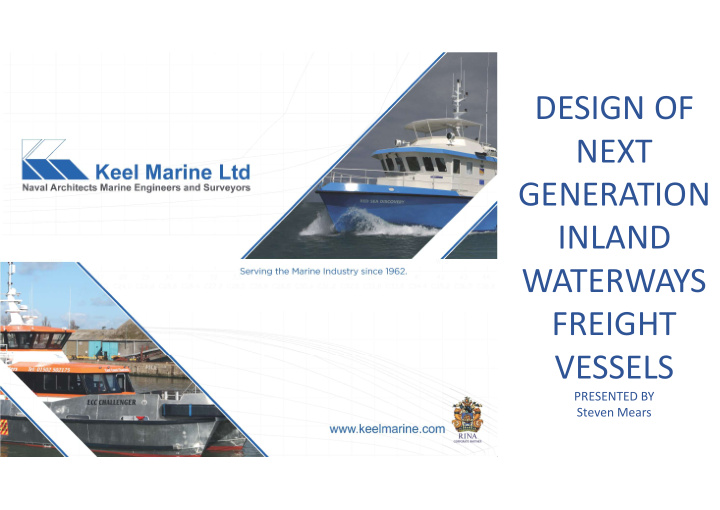



DESIGN OF NEXT GENERATION INLAND WATERWAYS FREIGHT VESSELS PRESENTED BY Steven Mears
Company Background Keel Marine are a consultancy specialising in naval architecture, marine engineering and survey for all vessel types, commercial and leisure, and of all sizes. The company has been in operation since 1962 and has been involved with vessels on the UK inland waterways system since the late ‘70s with clients over the years including; • Environment Agency • British Waterways • Port of London Authority • Transport for London • Thames Water Authority • Land & Water Services • Abwood Marine • Veolia • Airbus Industries • Ebsford Environmental
Design Drivers Increased Regulation All drivers interlinked with decisions in one area effected many others. Environmental Owners and designers must Considerations work together to find the most effective balance for a successful vessel. Crew Conditions
Increased Regulation As inland water ways traffic MCA Codes levels grow greater regulation Construction by various bodies is inevitable. & Stability Standards European Regulation Safety Equipment Navigation Standards Authorities Crewing Health & Safety Requirements Executive IMO & Working Conditions Environmental Operators and designers will Legislation need to engage with these bodies.
Medway Tug and Dredger Barge Hydraulic Latching System Hold Sized to Prevent Overloading Remotely Operated Crane
Welfare Facilities Medway Tug Toilet Space Medway Tug Wheelhouse Fitout Outfit on Windfarm Service Vessel
Environmental Emission reduction by; • Diesel Particulate Filters (DPF) • Key factor in environmental Selective Catalytic Reduction (SCR) • considerations will be exhaust Exhaust Gas Recirculation (EGR) • emissions standards. Fuel Based Solutions • Hybrid Power Sources All vessel based solutions. Removal of (local) emissions by use of full electric propulsion systems. Requires infrastructure upgrades.
Design Tools – British Waterways Barge Finite Element Analysis of structure allowed replacement of traditional bottom structure with single skin unstiffened thick plate
Design Tools – Cutting Files
Materials – Fibreglass Raising Wheelhouse
Hybrid and Electric Propulsion Thermal Runaway Typical Battery Installation
Next Generation Vessel Features • Steel hull, conventional shape • Alternative materials employed in other vessel structure • Good visibility • Technology to minimise manual handling by crew and reduce risk • Low or zero emission machinery for propulsion systems
Thank you for your attention
Recommend
More recommend